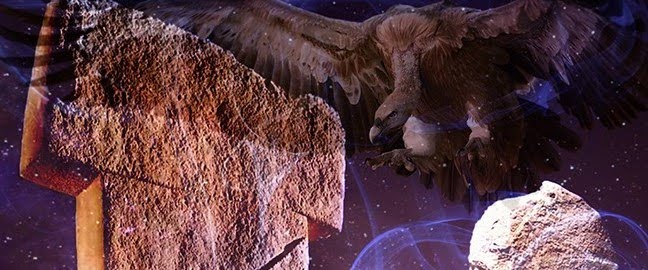Sokar is one of the most enigmatic entities
of Egyptian myth. Sokar was a falcon-headed God of the dead in later Egyptian
dynasties, and is believed one of the oldest Egyptian Gods. He was associated
with the vast necropolis of Giza, whose first funerary monuments predate the
pyramids by many centuries, and was invoked during funerary rites.
Sokar is linked to bja or meteoric
iron, which was in pre-metal eras a magical and devastating entity which
brought great gift and great destruction in equal measure. It was also linked
to the Bennu bird who instigated creation.
Sokar was invoked during funerary rites when
the deceased must successfully navigate various regions of the Duat or
underworld in order to reach eternal life. The realm of Sokar is a place which snatched
away the soul, a place of silence, a gate-keeper in darkness, as black as night.
Even the Sun God Ra, on his nightly journey through the underworld, could not
enter the realm of Sokar. A place to be avoided at all costs, even by the Gods.
Sokar as a God of the dead.
Many beliefs of Middle Eastern
civilisations developed from older cultures and traditions, and the origins of Egyptian
lore can be traced through the older cultures of Sumer and Iraq to the people
of Göbekli Tepe, who flourished 8000 years
before the dawn of Egyptian civilisation. There is no evidence that the stories
of Sokar originate in this period, but it is plausible. Sokar’s existence is
ancient and Egyptian lore itself states that Sokar was linked to the First Time,
the mythical Golden Age period when the Gods brought civilisation to earth
and has been linked to Göbekli Tepe.
Sokar is the realm whose corruptive influence
spreads through the entire land of Kur-Gal in Broken Skies. It was the
balance to the realm of creation, in a world where everything, no matter how
devastating, was a necessary part of existence. This influence is channelled by
a fallen star or meteorite, whose link to Sokar was known in Egyptian
lore.
As to its physical location in the sky, I
have linked it to the Pleiades star group, whose inconspicuousness in no way
equals its singular importance in star lore worldwide. This will be the subject
of next week’s post.
The
Pleiades. Juan lacruz, Wikicommons.













